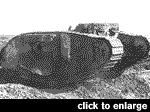 |
 |
The Weapons and Their Effects
In the 1914-1918 War about 12 per cent of all active service soldiers died. Total battle casualties on the Western Front, killed and wounded, have been estimated at over 50 per cent. Because of the determination to 'lead from the front', officers in combat suffered more severely than other soldiers, with about 17 per cent being killed. To realize fully the appallingly high level of death and mutilation, one should also remember that the ratio of fighting soldiers to support troops was about one to five, so that statistically very few actual frontline men could escape at least some form of wound.
Individual soldiers relied on their bolt-action rifles, the British .303 inch Short Magazine Lee Enfield (SMLE- 'Smellie' to the soldiers) and the German 7.92mm Mauser. But this was a dramatically 'modern' war with an ever increasing range of new weapons. The Germans brought out the flamethrower; the British the tank- a revolutionary tracked armoured fighting vehicle, armed with guns. A dreadful new weapon appeared early in April 1915--poison gas--introduced by the Germans at the Second Battle of Ypres, where Canadian and French troops were first to experience it. Soon the British were retaliating with their own gas, discharging it regularly with the prevailing westerly wind for the rest of the war. In all, Commonwealth forces had an estimated 250,000 gas casualties, of whom 10,000 died immediately, while the rest suffered to varying degrees.
|

















